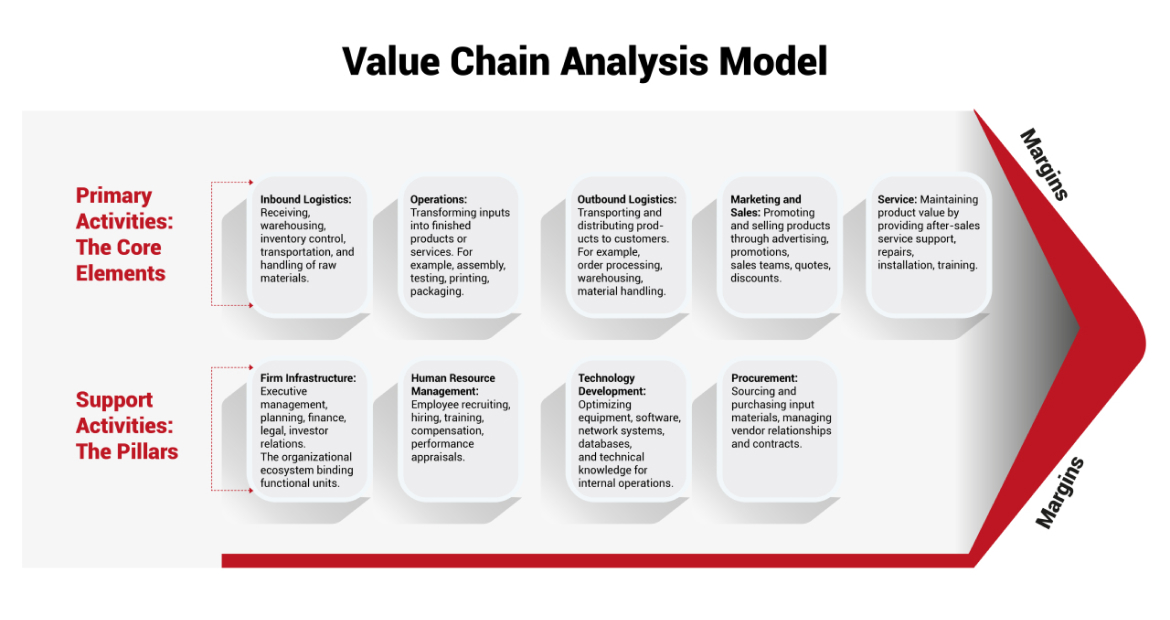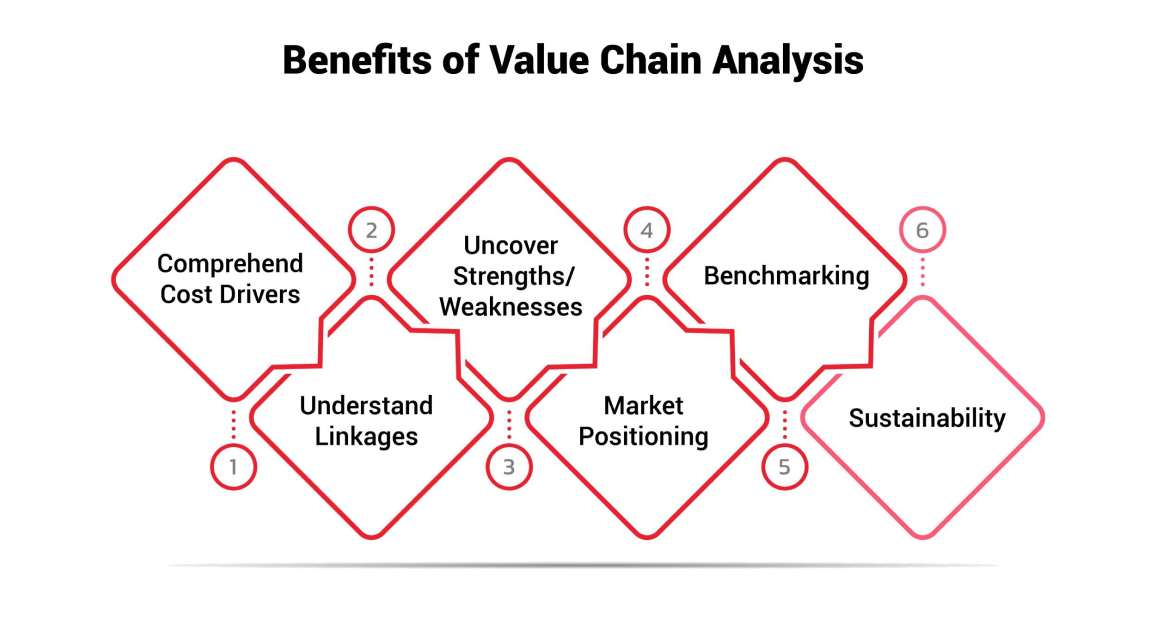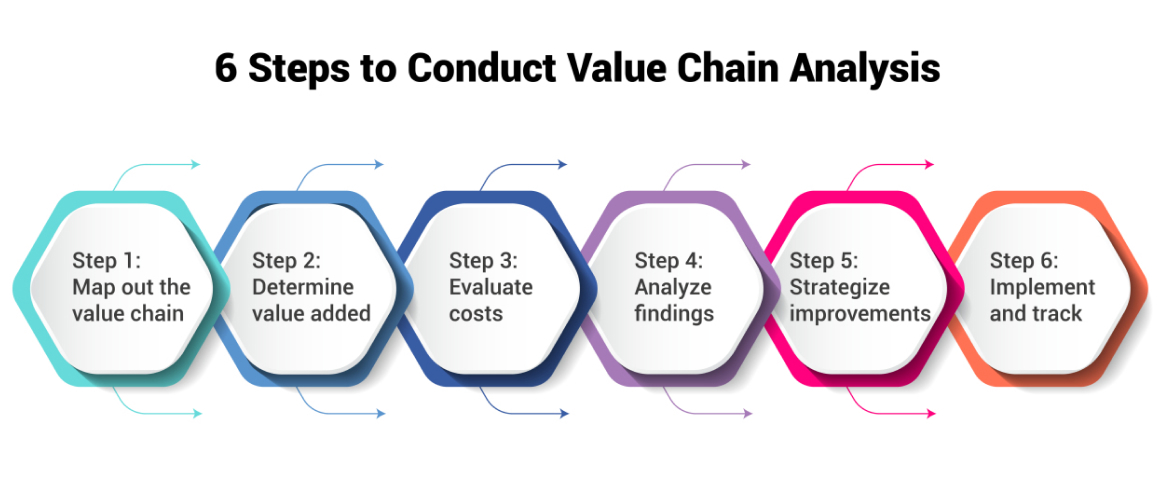A value chain is the backbone of any business, big or small. It encompasses all the steps required to conceptualize, produce, market, deliver, and support products or services. By breaking down these processes and thoroughly analyzing them, companies can uncover game-changing ideas to optimize operations, delight customers, and outflank competitors.
Understanding your company's value chain is essential for identifying opportunities to improve efficiency, reduce costs, and boost competitiveness. This article covers everything you need to know about value chain analysis.
A value chain refers to the series of activities a business performs to deliver a valuable product or service to its customers. It includes everything from product design, sourcing raw materials, manufacturing, marketing, delivery and after-sales service. Each step along the chain adds value to the product and creates costs for the business.
Analyzing the value chain helps companies understand how they can maximize value delivered to customers while improving profitability. As business strategy expert Michael Porter first explained in 1985, scrutinizing the value chain is key for gaining competitive advantage.
The Value Chain Analysis Model consists of primary activities that are directly involved in making and selling products or services and support activities that enable and enhance the primary functions.

Primary Activities: The Core Elements
The value chain constitutes twin facets – Primary Activities and Support Activities. Primary ones form the central nervous system, encompassing facets directly associated with transfiguring inputs into products and serving customers. They comprise:
Support Activities: The Pillars
While primary activities focus squarely on product or service creation and sales, support ones assist and reinforce them. Support activities consist of:
These two activity clusters craft a comprehensive blueprint of how businesses build and deliver value. Granular evaluation unmasks avenues for enhancing efficiency, exceeding customer expectations, and attaining durable competitive edges against rival firms.
By plainly showcasing the discrete steps in operations, product development teams can pinpoint the exact points for incorporating cutting-edge features or technologies. Sales and marketing staff can devise focused strategies based on target consumer priorities. Additionally, executives can allocate financial capital and human resources optimally between critical functions.
Now that you comprehend value chain architecture, how can applying it benefit your business? Value chain analysis assists organizations in multiple ways:

1. Comprehend Cost Drivers
Value chain analysis reveals the key cost drivers across an organization's business operations and processes. By breaking down the activities that contribute to delivering products or services into strategic relevant components, both primary activities and support activities, value chain analysis facilitates the identification of the main cost drivers within each activity.
Understanding cost drivers is crucial for several reasons:
Overall, a detailed breakdown of cost drivers through value chain analysis equips business leaders with vital information to formulate strategies that optimize efficiency and profitability. By concentrating efforts on high-impact cost drivers, companies can gain a competitive edge via lower costs and prices.
2. Understand Linkages
Another key benefit conferred by value chain analysis is an enhanced understanding of the linkages between various business activities, both within and between the primary and secondary categories. The value chain model highlights how the output from certain processes becomes the input for subsequent ones.
Several vital aspects rely on recognizing these interlinkages:
3. Uncover Strengths/Weaknesses
Comparison of a company's value chain with rivals also uncovers internal strengths and weaknesses. Primary activities that deliver superior value at lower costs than competitors are strengths to leverage further. Conversely, activities that lag behind rivals in efficiency or outcomes signal areas requiring modernization investments to close gaps.
Several strategic implications arise from identifying activity-level strengths and weaknesses:
Therefore, value chain analysis furnishes an X-ray of a company’s internal health across market-facing and behind-the-scenes operations, highlighting areas for targeted treatment to bolster competitive fitness.
4. Market Positioning
By providing clarity regarding customer needs and internal capabilities, value chain analysis aids companies in smarter market positioning.
Firstly, it fosters understanding distinct customer segments and their contrasting priorities. While some customers may be highly price-sensitive, others seek premium products with more features or customization.
Secondly, analysis of the firm's value creating activities reveals which needs it is best equipped to serve profitably. Playing to the company's strengths allows for delivering greater value to target customers.
Equipped with insights regarding customer preferences and internal competencies, companies can develop products, services, and marketing messages precisely tailored for niche clientele they can serve exceptionally well. This strategic positioning drives customer acquisition and retention by offering superior solutions to address the jobs-to-be-done.
Moreover, market positioning is a dynamic process requiring periodic re-evaluation as client needs, internal capabilities, and competitors evolve. Revisiting value chain analysis facilitates necessary course corrections - realigning offerings with demand and reconfiguring operations to capabilities required for new customer solutions.
5. Benchmarking
An accurate comprehension of a company’s value chain architecture and performance metrics enables insightful comparisons and benchmarking against industry best practices.
Leading companies define process standards and service levels across important value chain activities and continually measure themselves against these benchmarks. This pursuit of operational excellence involves:
Through such benchmarking, companies assimilate capabilities and process improvements necessary for competing at the highest levels. This builds formidable competitive barriers against rivals still grappling with subpar performance.
6. Sustainability
Value chain analysis also plays an invaluable role in evaluating and enhancing the environmental sustainability of business operations. With rising societal consciousness and stringent regulations around ecological impact, embracing green pathways is imperative for responsible companies.
From raw material sourcing to manufacturing, distribution channels and product disposal, value chain analysis can pinpoint activities accounting for significant portions of the company’s environmental footprint. Establishing baseline impact metrics and identifying hotspots facilitates targeted strategies to diminish contribution to climate change, pollution, and resource depletion.
Common interventions include:
Building sustainability considerations into decision frameworks for each value chain activity cultivates positive habits that compound into substantial collective impact over the long-term. With looming climate crisis threats, future-fitness demands environment-centric value chains.
Follow these six steps to harvest the fruits of value chain analysis fully:

Step 1: Map out the value chain
The first step is to map out all the primary and support activities in your company's value chain. This involves:
This value chain mapping provides a holistic, systematic overview of your business processes so you can analyze how each contributes to competitive advantage.
Step 2: Determine value added
With the value chain mapped out, analyze each activity to estimate how much value it adds to the final output delivered to customers.
Assess parameters like:
Rank the activities from high to low value. This quantifies their contribution and helps you identify low-value procedures.
Step 3: Evaluate costs
Calculating the costs and investments associated with each activity is crucial for determining profitability. Gauge:
Add these figures to build an activity-wise cost structure. This offers visibility into expensive procedures.
Step 4: Analyze findings
With value and cost analysis complete, scrutinize your value chain to uncover:
Step 5: Strategize improvements
Use analysis insights to develop strategies and resource allocation plans for incrementally enhancing the value chain.
For low-value activities, set tangible targets, budgets and timelines to lift productivity and decrease costs through process improvements, tech integration etc.
For high-value activities, strategize scaling, marketing and technical plans to extract greater value from them.
Step 6: Implement and track
The final step is strategy execution with robust tracking mechanisms to gauge progress. Monitor relevant quantitative metrics as changes roll out to address bottlenecks promptly. With regular value chain analysis and strategic enhancements, you can achieve enduring competitive advantage.
Let us explore a value chain example to demonstrate how this framework plays out in the real world. Consider multimedia giant Netflix, which has disrupted the entertainment industry exponentially through its on-demand streaming platform.
A high-level value chain analysis of Netflix would entail:
Support activities would encompass aspects like proprietary media production technology investments, hiring creative talent and software developers, securing legal rights to stream licensed content globally, and forging mutually beneficial partnerships with content creators and cloud infrastructure providers.
By meshing insights derived from scrutinizing these constituents, Netflix can craft strategies like launching lower-priced streaming plans with advertisements or doubling down on regional language content production to court new members. Resultantly, stitching together granular understandings of how this value chain operates has empowered Netflix to completely overhaul viewer entertainment preferences within a decade.
The value chain model furnishes indispensable inputs for erecting and implementing strategies harmonized with operational realities, organizational objectives, and customer preferences. Conducting value chain analysis unearths potential chokepoints and untapped opportunities to refine internal activities.
While individual constituents reveal useful inferences, examining linkages between them exposes invaluable interdependencies. Technology developments cannot occur in isolation from infrastructure capabilities or human skills. Neither can production scale efficiently without robust marketing feedback loops informing output calibration.
By regularly revisiting value chain analysis, executives can adapt strategies dynamically to market fluctuations and global uncertainties. Ultimately, this analytical tool empowers enterprises to perpetually orchestrate value-accretive transformations at every link in their organizational chain!

CredBadge™ is a proprietary, secure, digital badging platform that provides for seamless authentication and verification of credentials across digital media worldwide.
CredBadge™ powered credentials ensure that professionals can showcase and verify their qualifications and credentials across all digital platforms, and at any time, across the planet.

Keep yourself informed on the latest updates and information about business strategy by subscribing to our newsletter.